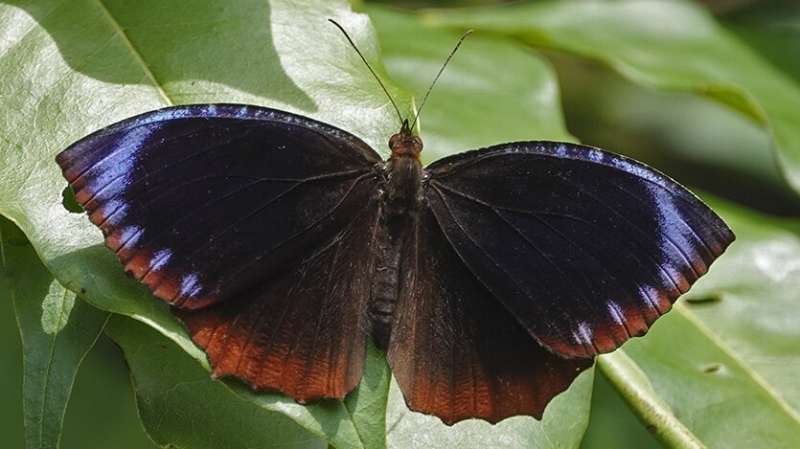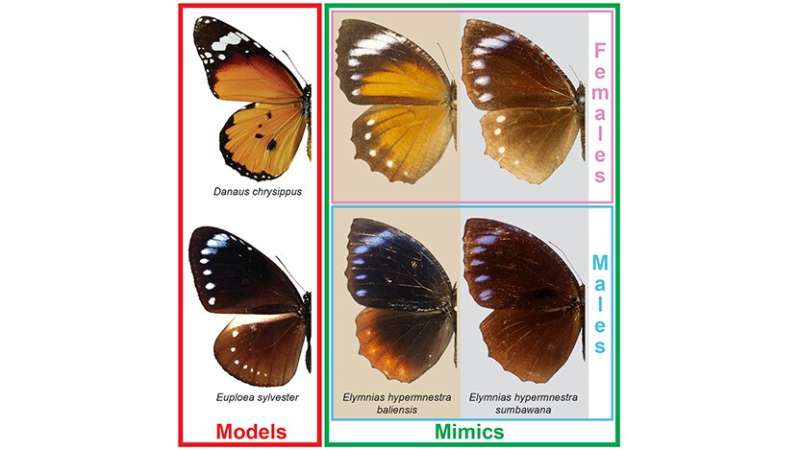Asian butterfly populations show different mimicry patterns thanks to genetic 'switch'

A new study by researchers at the University of Chicago and the City College of New York (CCNY) has identified a unique, genetic "mimicry switch" that determines whether or not male and female Elymnias hypermnestra palmflies mimic the same or different species of butterflies. The results indicate that sexual dimorphism has repeatedly emerged in different palmfly populations, and linked the trait to a gene associated with melanin localization and regulation.
Published on Jan. 13 in the journal Royal Proceedings of the Academy B, these results can help scientists start to better understand the genetics underlying phenotypic differences between males and females in the animal kingdom, investigators say.
"Many animal species show sexual dimorphism, while others aren't very sexually dimorphic," said co-senior author Marcus Kronforst, Ph.D., a professor in the Department of Ecology and Evolution at UChicago. "In Elymnias hypermnestra, we have a weird situation within one species where nearby populations show different patterns. This is a special opportunity to get at the underlying genetics of sexual dimorphism."
Elymnias hypermnestra, native to southeast Asia, represent an ideal model for this study due to their unusual mimicry patterns. In some populations, male and female butterflies are sexually monomorphic, meaning they resemble one another; in this case, both males and females mimic species in another genus of butterfly, Euploea, with dark-colored wings with light spots. In other populations, males and females are sexually dimorphic, and mimic two different species of butterfly—while males still mimic Euploea species, females instead mimic species of Danaus, with orange-patterned wings.
In the study, the researchers collected and sequenced the genomes of 48 individual butterflies from locations across southeast Asia, from Thailand to the Spice Islands in Indonesia; some were from sexually dimorphic populations, while others were from sexually monomorphic populations.

To their surprise, genetic analysis revealed that rather than splitting neatly into two groups, sexual dimorphism arose repeatedly in different populations. "This is a really neat case of never-before-seen repeated traits; this sexual dimorphism has appeared repeatedly in these butterflies," said first author Dee Ruttenberg, now a graduate student at Princeton University. "What's more, when we look at these individual groups of sexually dimorphic butterflies, we found that one gene popped up repeatedly, and predicted if a butterfly would be monomorphic or dimorphic almost perfectly—that's WntA."
Important in a wide range of similar butterfly species and associated with melanin localization and regulation, the research team called WntA a "smoking gun"—the gene is well known for being involved in pigmentation in butterflies, and now appears to be regulating the transition between sexual dimorphism and monomorphism. The benefit is that individual populations of the butterfly can rapidly and easily "flip the switch" based on local pressures.
"We identified two key base pairs in a region of DNA that seems to be associated with regulating the activity of WntA," said co-senior author David Lohman, Ph.D., an associate professor of biology at CCNY. "It seems like there are a fairly small number of genetic changes that contribute to this difference in female form, and it's likely that this represents an example of gene reuse. The genetic machinery to make an orange wing or black wing didn't evolve de novo but rather those sets of genes are turned on and off depending on the population. It really is like a mimicry switch."
Because this butterfly is relatively understudied, the research is the first to clarify the distribution of this trait and the underlying genetics, but what is less clear is why. "We can go into the field and document these population patterns and then go in and find the genetic mechanism, but what we don't know is, why is it that some populations have orange females and others don't?" said Lohman. "Is it because the orange species that the females might mimic are rare or absent? Or that they're not particularly toxic, so mimicking an orange species wouldn't be very beneficial to the females?"
The other major remaining question is how the WntA gene is regulated in a sexually dimorphic way. "How is it that this gene that, up to this point, we have had no reason to think might be associated with sexual dimorphism, is now being regulated in that way?" said Ruttenberg. "Is there a pathway by which sexually dimorphic expression could be created in any gene?"
In future research, the investigators hope to dig more into how exactly WntA regulates the monomorphic and dimorphic color patterns.
More information: Dee M. Ruttenberg et al, The evolution and genetics of sexually dimorphic 'dual' mimicry in the butterfly Elymnias hypermnestra, Proceedings of the Royal Society B: Biological Sciences (2021). DOI: 10.1098/rspb.2020.2192
Journal information: Proceedings of the Royal Society B
Provided by University of Chicago Medical Center





















